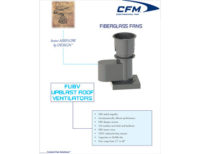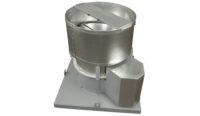A quality experience within the stadium was a key reason the Brewers drew 2.8 million fans during 2001 - 74% more than in the previous season. Faced with competing in a small major league market, the Brewers regard the climate-controlled stadium as critical to their efforts to raise the revenue necessary to field a winning team.
Miller Park's signature is its fan-shaped convertible roof - the only one of its kind in the United States. The $400 million ballpark also offers numerous amenities, such as luxury suites, 30 concession stands, a fine-dining restaurant and bar, as well as grills and assorted meeting rooms.
Scott Jenkins, the Brewers' vice president of stadium operations, oversaw the design and construction of the park. He now supervises the daily challenges involved in keeping fans comfortable despite the widely variable weather in Milwaukee. Jenkins' 28-member staff includes a five-person O&M team under contract from Johnson Controls (Milwaukee).
Johnson Controls participated in the stadium project from design through construction and commissioning. The company's Metasys(r) bas controls hvac for the stadium. Along with advanced lighting controls, it helped Jenkins bring in first-year utility costs 20% below an original estimate based on benchmarking of other new sports stadiums - that despite a spike in natural gas prices that lasted through the winter of 2000-2001.
Delivering a winner
Miller Park's 74 luxury boxes are an essential source of revenue for the Brewers. To meet suite holders' comfort needs, each suite's space conditions are controlled individually through the bas. The same control system also regulates the temperature beneath the roof."Because utility expense is one of our largest line items, it's something that has our attention. Our energy costs at Miller Park are four times higher than in the old stadium, so it's critically important that we operate efficiently," Jenkins noted.
"In 2001, we had a cold spring. We actually had to heat the building for the first couple of games in June," he stated. The operations staff aims to ensure fan comfort without turning on the heat prematurely and thus wasting energy. "We spend about $1,000 an hour to heat the bowl, so it's very important to make wise decisions on when to turn things on," Jenkins said.
To help make good decisions, the operations staff monitors various weather sites on the Internet. "One of the beauties of the bas is the ability to monitor what the discharge temperatures are, what the return temperatures are, and what bowl space temperatures are," adds Jenkins. "Because of that, we have been able to provide a very comfortable environment, irrespective of what's going on outside. For baseball fans in our climate, that is a tremendous asset."

Fans for the fans
Heat for the seating bowl comes from 18 indirect-gas-fired Mammoth (Chaska, MN) heaters delivering a combined 68,200 MBtuh, and from eight Trane (La Crosse, WI) built-up AHUs with 11 Trane supply fans that deliver 1.1 million cfm.The Bryant (Indianapolis) gas heaters, located on the terrace and field levels, discharge through ductwork and diffusers on those levels and on the loge and terrace levels. The AHUs, fed by hot water from the stadium's four gas-fired boilers (total 33,600 MBtuh) are located on the service level behind the field-level seats. Fans force air into the seating bowl through slots cut into the concrete stands.
During cold weather games to be played under the roof, stadium personnel activate the heaters at a predetermined hour before game time - early enough to ensure fan comfort. Sensors in the gas-fired heating units monitor return air temperature; the bas then modulates the burner flames to maintain the desired temperature.
The air stays cooler on the playing field and in the outfield sections of seats, where outside air enters along the track beam at the base of the roof and through joints in the outfield wall which, like the roof, can be opened and closed. Natural convection occurs as newly introduced warm air rises and cooler infiltrating air settles.
During the Brewers' 81-game home season, the roof was closed for rain or cold during 30 games. In about half those cases, the heat was on. "We had days when it was 30 degrees outside, and windy - not at all baseball weather," Jenkins said. "But when you came in here space temperatures were 65 degrees F to 68 degrees."ES





